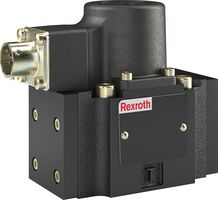
Bosch Rexorth Directional servo-valve 4WS2EM6-2X/20B11ET315K17BV R901270775 Rexroth


Valves of type 4WS2EM …XL are electrically operated, 2-stage directional servo valves. They are mainly used to control position, force, pressure or velocity.
The valves consist of an electro-mechanical converter (torque motor) (1), a hydraulic amplifier (nozzle flapper plate system) (2) and a control spool (3) in a sleeve (2nd stage), which is connected to the torque motor via a mechanical feedback.
An electrical input signal at the coils (4) of the torque motor generates a force by means of a permanent magnet which acts on the armature (5), and in connection with a torque tube (6) results in a torque. This causes the flapper plate (7) which is connected to the torque tube (6) via a bolt to move from the central position between the two control nozzles (8), and a pressure differential is created across the front sides of the control spool (3). The pressure differential results in the control spool changing its position, which results in the pressure port being connected to one actuator port and, at the same time, the other actuator port being connected to the return flow port.
The control spool (3) is connected to the flapper plate or the torque motor by means of a bending spring (mechanical feedback) (9). The position of the control spool (3) is changed until the feedback torque across the bending spring and the electro-magnetic torque of the torque motor are balanced and the pressure differential at the nozzle flapper plate system becomes zero.
The stroke of the control spool (3) and consequently the flow of the servo valve are controlled proportionally to the electrical input signal. It must be noted that the flow depends on the valve pressure drop.
External control electronics (separate order)
External control electronics (servo amplifier) serve the actuation of the valve, amplifying an analog input signal (command value) so that with the output signal, the servo valve is actuated in a flow-controlled form.
For the limitation of the electric data, a safety barrier is to be connected between valve and amplifier (see “Electrical connection”).
- Size 6
- Component series 2X
- Maximum operating pressure 315 bar
- Maximum flow 48 l/min
- Area of application in accordance with the Explosion Protection Directive 2014/34/EU: II 3G
- Type of protection: Ex ic IIC T4 Gc according to EN 60079-0 / EN 60079-11


